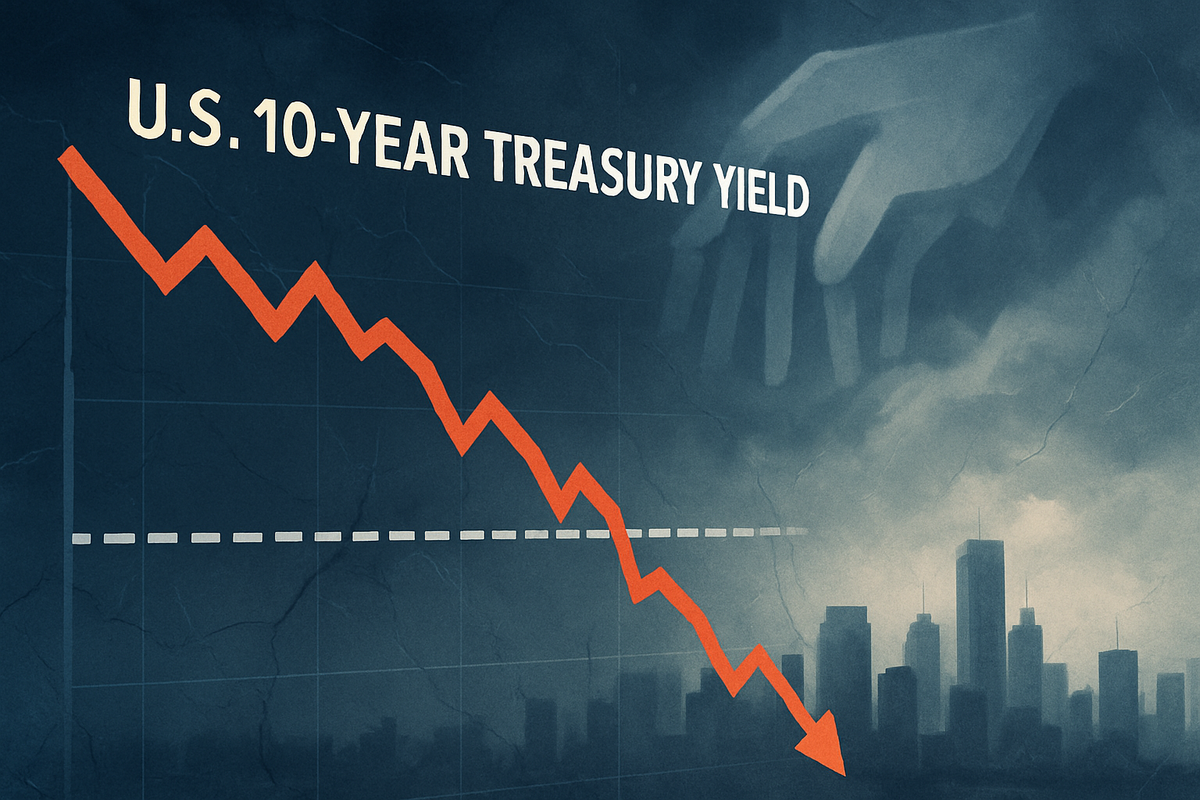
New York, NY – October 16, 2025 – The financial markets are abuzz today as the U.S. 10-Year Treasury Yield dramatically tumbled below the critical 4% threshold, a move that reverberates through global economies and intensifies concerns over the health of the U.S. economy. This significant shift in bond yields is widely interpreted as a clear signal of heightened economic jitters among investors, who are increasingly seeking the safety of government bonds amidst a landscape clouded by uncertainty. The plunge suggests a strong market expectation for an accelerated dovish pivot from the Federal Reserve, with futures markets now pricing in multiple interest rate cuts in the near future.
This "flight to safety" underscores a prevailing "risk-off" sentiment, indicating that investors are prioritizing stability over higher-risk, higher-reward assets. The implications are immediate and far-reaching, hinting at potentially cheaper borrowing costs across various sectors, from mortgages to corporate loans, but also reflecting a deep-seated apprehension about weakening economic growth prospects and the looming specter of a recession. The market's aggressive repricing of future interest rates puts immense pressure on the Federal Reserve to act decisively, potentially accelerating their accommodative monetary policy to stave off a more significant economic downturn.
Detailed Coverage: A Dive into the Market's Unease
The dramatic drop in the U.S. 10-Year Treasury Yield below 4% on October 16, 2025, marks a pivotal moment in the current economic cycle, reflecting a confluence of factors that have been brewing for months. The yield, a key benchmark for global interest rates, saw sustained selling pressure on riskier assets, particularly equities, as capital rapidly flowed into the perceived safety of U.S. government bonds. This surge in demand for Treasuries pushed their prices up and, consequently, their yields down, culminating in today's significant breach of the 4% level.
Leading up to this moment, a series of economic indicators had painted an increasingly fragile picture. The Philadelphia Fed Manufacturing Index recently delivered a dismal reading, pointing to a sharp contraction in manufacturing activity. Concurrently, the labor market has shown signs of weakening, with declining new job additions and subdued demand for labor, contrasting sharply with earlier expectations of a robust jobs recovery. These domestic concerns have been exacerbated by external pressures, including escalating U.S.-China trade tensions, which threaten global supply chains and economic stability, and lingering political uncertainties such as threats to Federal Reserve independence and the potential for a prolonged U.S. government shutdown.
Key players are now squarely in the spotlight, none more so than the Federal Reserve. Recent comments from Fed Chair Jerome Powell on October 14, 2025, seem to have solidified market expectations for further rate cuts, building upon an initial cutting cycle that commenced in September due to persistent labor market weakness. The Treasury Department, as the issuer of these benchmark bonds, also plays a crucial role, as the demand for its debt reflects global confidence in the U.S. economy. Initial market reactions have been swift: equity markets have shown volatility, with a general downtrend in risk assets, while gold and other safe-haven commodities have seen an uptick in demand. Analysts from major financial firms are now forecasting further rate declines, with a significant shift of investor funds from short-term to long-term bonds, suggesting a collective belief that current rates are "high" given the economic trajectory.
Companies Navigating the Shifting Sands: Winners and Losers
The sharp decline in the U.S. 10-Year Treasury Yield below 4% on October 16, 2025, will undoubtedly create a distinct divide between winners and losers in the corporate landscape, as borrowing costs and investor sentiment undergo a significant recalibration. Companies with high growth potential, particularly in the technology and innovation sectors, are poised to benefit. Lower interest rates reduce the discount rate applied to their future earnings, making their long-term growth prospects appear more attractive to investors. Tech giants like Apple (NASDAQ: AAPL), Microsoft (NASDAQ: MSFT), and emerging biotech firms, which often rely on future profitability, could see increased investor interest as the cost of capital decreases and growth valuations become more compelling.
Conversely, the financial sector, particularly traditional banks, may face headwinds. While lower rates can stimulate borrowing, they also compress net interest margins (NIMs), the difference between what banks earn on loans and pay on deposits. Institutions like JPMorgan Chase (NYSE: JPM) and Bank of America (NYSE: BAC) might experience reduced profitability from their core lending activities. However, mortgage lenders could see a surge in refinancing activity, offering a silver lining for some segments of the banking industry.
Real estate investment trusts (REITs) and other interest-rate-sensitive sectors present a mixed picture. Lower mortgage rates could stimulate housing demand, benefiting homebuilders like D.R. Horton (NYSE: DHI) and real estate developers. However, if the yield decline is driven by deep recession fears, overall consumer confidence and spending on big-ticket items like homes could still suffer. Companies with significant debt loads, across all sectors, could find relief as refinancing becomes cheaper, improving their balance sheets and freeing up capital for investment or shareholder returns. Conversely, companies heavily reliant on consumer discretionary spending, such as certain retail chains or luxury goods providers, might struggle if the underlying economic jitters translate into reduced consumer confidence and spending.
Wider Significance: A Bellwether for Broader Economic Trends
The U.S. 10-Year Treasury Yield's fall below 4% on October 16, 2025, is far more than a mere numerical adjustment; it serves as a critical bellwether, signaling profound shifts in broader economic trends and potentially reshaping the regulatory and policy landscape. This event underscores a growing global consensus that the era of persistently high inflation might be receding, giving way to concerns about decelerating economic growth or even a mild recession. It fits into a broader trend of central banks worldwide grappling with the delicate balance between taming inflation and supporting fragile economies, with many now leaning towards more accommodative stances.
The ripple effects of this yield plunge are expected to be extensive, impacting not just competitors and partners within the U.S., but also global markets. Emerging markets, which often see capital flow out during "risk-off" periods, could face increased pressure on their currencies and bond yields. Conversely, a weaker U.S. dollar, often a consequence of lower rates, could provide some relief to countries with dollar-denominated debt. Regulatory bodies, including the Federal Reserve and potentially the Treasury Department, will face intensified scrutiny and pressure to implement policies that stabilize markets and support economic activity. Discussions around unconventional monetary tools, such as "yield curve control," while still a high bar, may re-enter the policy discourse as the Fed seeks to manage long-term borrowing costs.
Historically, sustained declines in the 10-Year Treasury Yield have often preceded or coincided with periods of economic slowdowns or recessions. For instance, the yield curve inversions that preceded the 2000 dot-com bust and the 2008 financial crisis serve as stark reminders of the yield curve's predictive power. While a direct inversion isn't the sole factor here, the current yield movement, driven by a "flight to safety," echoes similar investor behavior seen in past periods of heightened uncertainty. This historical context suggests that policymakers and investors alike should view this development not as an isolated incident, but as a critical indicator of deeper economic currents at play, demanding careful consideration and strategic adjustments.
What Comes Next: Navigating the New Economic Reality
The immediate aftermath of the 10-Year Treasury Yield tumbling below 4% will be characterized by continued market volatility and intense speculation regarding the Federal Reserve's next moves. In the short-term, we can expect equity markets to remain sensitive to incoming economic data, particularly inflation reports and labor market statistics, which will directly influence the Fed's policy trajectory. Bond markets will likely see continued demand, especially for longer-duration Treasuries, as investors seek to lock in yields before potential further cuts. Companies with strong balance sheets and consistent cash flow will be better positioned to weather this uncertainty, while those with significant debt or reliance on robust consumer spending may face increasing challenges.
Looking further ahead, the long-term possibilities suggest a prolonged period of lower interest rates, potentially reshaping capital allocation and investment strategies across industries. This could spur a resurgence in mergers and acquisitions, as cheaper financing makes deals more attractive. Businesses may need to adapt strategically, prioritizing efficiency and cost control, while also exploring opportunities for growth that are less sensitive to economic cycles. For instance, defensive sectors such as utilities and consumer staples might gain favor.
Market opportunities could emerge in sectors that benefit from lower borrowing costs, such as real estate and infrastructure development, assuming underlying demand remains resilient. Furthermore, companies focused on innovation and digital transformation, which can thrive even in slower growth environments, might attract sustained investment. Challenges will include managing reduced profit margins for financial institutions and navigating a potentially disinflationary environment. Potential scenarios range from a "soft landing" where the Fed successfully engineers a mild slowdown to control inflation without triggering a deep recession, to a more challenging "hard landing" marked by a significant economic contraction if the underlying jitters prove more severe than anticipated. Investors should brace for a period where economic data dictates market sentiment, and the Federal Reserve's communications become paramount.
Wrap-up: A New Chapter of Caution and Opportunity
The dramatic plunge of the U.S. 10-Year Treasury Yield below 4% on October 16, 2025, serves as a pivotal moment, encapsulating a confluence of economic jitters and a clear market demand for a more dovish Federal Reserve. The key takeaway is a significant shift in investor sentiment from risk-on to risk-off, driven by concerns over weakening economic growth, geopolitical tensions, and domestic uncertainties. This event not only signals impending interest rate cuts by the Fed but also points to a potential recalibration of valuations across various asset classes, favoring safe havens and potentially growth-oriented companies over interest-rate-sensitive financial institutions.
Moving forward, the market will likely be characterized by increased vigilance, with every piece of economic data and every Fed pronouncement scrutinized for clues about the future trajectory of monetary policy and the broader economy. While lower borrowing costs could offer some respite for indebted companies and stimulate certain sectors, the underlying cause—deep-seated economic concerns—cannot be overlooked. The period ahead demands a nuanced approach from investors, balancing the pursuit of growth with a robust risk management strategy.
In the coming months, investors should closely watch the Federal Reserve's actions, particularly their interest rate decisions and forward guidance. Furthermore, monitoring key economic indicators such as inflation rates, employment figures, and manufacturing indices will be crucial for assessing the true depth of the economic slowdown. The 10-Year Treasury Yield's move below 4% is not merely a technical adjustment; it's a powerful signal that the financial landscape is undergoing a significant transformation, ushering in a new chapter defined by caution, strategic adaptation, and the emergence of distinct opportunities amidst uncertainty.
This content is intended for informational purposes only and is not financial advice





